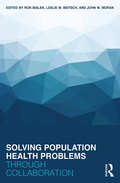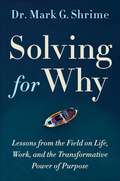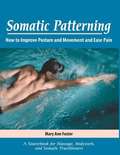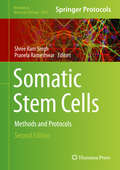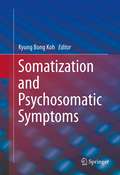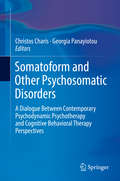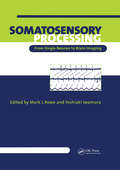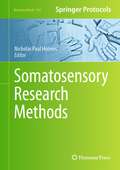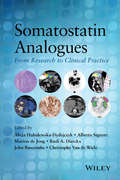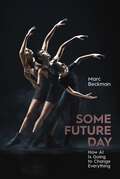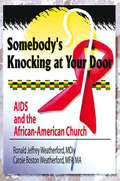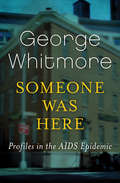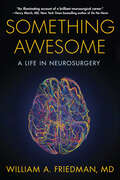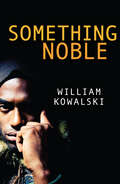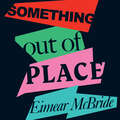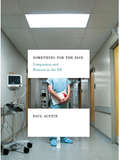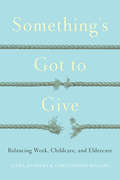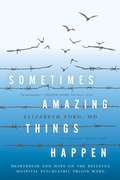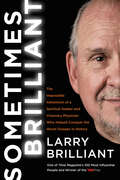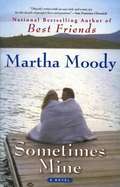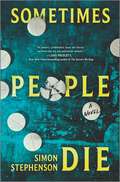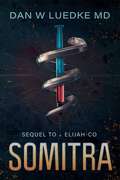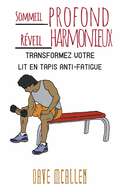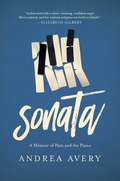- Table View
- List View
Solving Population Health Problems through Collaboration
by John W. Moran Leslie M. Beitsch Ron BialekRapid changes in healthcare and public health offer tremendous opportunities to focus on process improvement. Public health departments and agencies increasingly work collaboratively with hospitals and other community partners to promote knowledge and improve collective impact through public and private sector coalitions. Solving Population Health Problems through Collaboration brings together population health experts and leaders to examine evidence-based intervention strategies, case studies in health departments and hospitals, health equity issues, core competencies, public health campaigns, step-by-step collaboration advice, and much more. Each chapter is written by a population health leader shaped by his or her experience implementing change in a community’s health, to demonstrate innovative methods and tools for building and leading sustainable community coalitions to effect real change. Designed to prepare population health workers in public health and healthcare settings to develop strategies for improved population health, this book is required reading for public health managers and health administrators as well as students enrolled in population health courses.
Solving for Why: A Surgeon's Journey to Discover the Transformative Power of Purpose
by Dr. Mark ShrimeFrom Mercy Ships surgeon Dr. Mark G. Shrime comes an inspiring memoir about finding the answer to life's biggest question—"Why?"—and about following that answer through remarkable, unlikely places on the road to fulfillment, purpose, and joy.SOLVING FOR WHY chronicles one man's journey to find the answer to the biggest of all life's questions: "Why?" Following a traumatic car accident, Dr. Shrime—the child of Lebanese immigrants fleeing a civil war, who later became a successful practicing surgeon in Boston—found himself compelled to change the course of his life, determined to find meaning and satisfaction even if it meant diverting from America&’s idea of &“success.&” Featuring stories, insights, and research from his own exceptional life and work, SOLVING FOR WHY is the story of Dr. Shrime's search for—and discovery of—lifelong fulfillment. Now a global surgeon operating on a hospital ship docked off the coast of West Africa and one of the few global experts on surgery in low- and middle-income countries, Dr. Shrime seeks to impart the wisdom of the lessons he&’s learned over the course of his search for a life of true contentment. In the tradition of Dr. Paul Farmer's To Repair the World, Dr. Atul Gawande's Better, and Dr. Michele Harper's The Beauty in Breaking, SOLVING FOR WHY combines personal stories with deep, thoughtful research into the challenges of working in modern medicine in the 21st century and the commodification of work in America. A story of discovery and transformation, SOLVING FOR WHY seeks to help readers answer the &“why&” of their own lives and ultimately find joy outside the status quo.
Somatic Patterning: How to Improve Posture and Movement and Ease Pain
by Mary Ann Foster<p>A comprehensive sourcebook for massage, bodywork, and somatic practitioners and their clients. Also, a great resource for dance, exercise, or yoga teachers and their students. With numerous illustrations, photos, special features, and somatic exercises, this text is user-friendly. Practitioners are even encouraged to photocopy exercises to give to their clients. <p>Somatic Patterning covers a broad spectrum of topics, including early motor development, body-mind awareness, pain relief, breathing, postural muscles, organic movement, and basic kinesiological patterns. And, it is well-documented with comprehensive glossary, endnotes, bibliography, and index.
Somatic Stem Cells: Methods And Protocols (Methods in Molecular Biology #879)
by Shree Ram Singh Pranela RameshwarThis second edition volume expands on the previous edition with updated discussions on new genetic, molecular, and cellular methods used to study somatic stem cells. The chapters in this book focus on the isolation, classification, purity, and plasticity of these stem cells in a variety of organic tissues. Written in the highly successful Methods in Molecular Biology series format, chapters include introductions to their respective topics, lists of the necessary materials and reagents, step-by-step, readily reproducible laboratory protocols, and tips on troubleshooting and avoiding known pitfalls.Cutting-edge and comprehensive, Somatic Stem Cells: Methods and Protocols, Second Edition is a valuable resource for both novice and experienced molecular biologists, developmental biologists, tissue engineers, and geneticists who are interested in stem cell research and its potentials in regenerative medicine.
Somatization and Psychosomatic Symptoms
by Kyung Bong KohThis book, with contributions emanating from the 21st World Congress of Psychosomatic Medicine held in Seoul in August 2011, presents the latest evidence-based information about the mechanisms, assessment, and management of psychosomatic disorders from a biopsychosociocultural perspective. Somatization is a process characterized by excessive or inappropriate focus on physical symptoms that are medically unexplained. It is highly prevalent in primary care medicine, as somatoform (psychosomatic) disorders tend to be chronic and can cause significant personal suffering and social problems as well as financial burden.
Somatoform and Other Psychosomatic Disorders: A Dialogue Between Contemporary Psychodynamic Psychotherapy and Cognitive Behavioral Therapy Perspectives
by Christos Charis Georgia PanayiotouThis intriguing volume presents the most contemporary views on the conceptualization and treatment of somatoform disorders and related conditions from experts in psychodynamic and cognitive behavioral approaches. It does so with respect to both perspectives, without advocating for either approach. By presenting expert views from diverse perspectives, the book raises, what is a central point in most of the chapters, that emotion, its processing and regulation, is a cornerstone of these disorders. The volume also highlights the role of pathogenic coping or defense mechanisms like dysfunctional avoidance (from a CBT perspective) and conversion (from the psychodynamic perspective) in the maintenance of psychosomatic symptoms. The volume’s contents include detailed literature reviews on the most common—and most treatment-resistant—mind/body conditions, including chronic pain, responses to trauma, alexithymia, and the spectrum of health anxiety disorders. Noted experts distinguish between types of medically unexplained symptoms, discuss their complex processes, and provide models for intervention where cognitive-behavioral or psychodynamic approaches may be appropriate or effective. And a fascinating case study of a patient presenting multiple trauma-related disorders explores therapist resourcefulness over a course of shifting symptoms and frustrating setbacks. Among the topics covered: Maintaining mechanisms of health anxiety: current state of knowledge.Negative affect and medically unexplained symptoms.Alexithymia as a core trait in psychosomatic and other psychological disorders.Trauma and its consequences for body and mind.Embodied memories, a new pathway to the unconcious.Psychotherapy among HIV patients: a look at a psychoimmunological research study after 20 years.Health anxiety: a cognitive-behavioral framework. The wealth of options discussed in Somatoform and Psychosomatic Disorders offers health psychologists, psychiatrists, psychotherapists, counselors, and psychoanalysts bold new ideas for case formulation, treatment planning, and intervention with some of their most intractable cases.
Somatosensory Processing: From Single Neuron to Brain Imaging
by Mark Rowe Yoshiaki IwamuraThe diversity of contemporary investigative approaches included in this volume provides an exciting account of our current understanding of brain mechanisms responsible for sensory and perceptual experience in the areas of touch, kinesthesia, and pain.Postgraduate research students in sensory physiology, neurology, psychology and anatomy, and r
Somatosensory Research Methods (Neuromethods #196)
by Nicholas Paul HolmesThis volume provides methods on the study of the systems of the brain. Chapters are divided into four parts covering; discriminative touch, proprioception and kinaesthesis, affective touch, individual differences due to atypical development, ageing, illusions and sensory substitution, microneurography, electrophysiology, brain imaging, and brain stimulation. In Neuromethods series style, chapters include the kind of detail and key advice from the specialists needed to get successful results in your research center and clinical investigation. Thorough and comprehensive, Somatosensory Research Methods aims to be comprehensive guide for researchers.
Somatostatin Analogues
by Alberto Signore Christophe Van de Wiele Rudi A. Dierckx Alicja Hubalewska-Dydejczyk John Buscombe Marion De JongFeaturing chapters from specialists in endocrinology, physiology, pathology, and nuclear medicine, this book provides a multidisciplinary approach to a wide variety of issues concerning somatostatin and its analogues. The book: Provides the most up-to-date coverage of somatostatin analog use in diagnostic and therapy Integrating the specialties of endocrinology, physiology, pathology, and nuclear medicine, providing the multidisciplinary approach to the topic Focuses on future applications, novel compounds, and areas for further research Covers topics by authors who are renowned experts and researchers in the field
Some Choice: Law, Medicine, and the Market
by George J. AnnasThe authors goal is to help open a deep and democratic dialogue on health and human rights that trancends slogans and chants, and can lead to local, national, and international cooperation to define, protect, and promote both health and human rights.
Some Future Day: How AI Is Going to Change Everything
by Marc BeckmanThis cutting-edge guide not only shows how AI is transforming our careers, lives, businesses, and more, but also provides easy, actionable steps to make AI work for us. In this groundbreaking book, celebrated professor, entrepreneur, author, and podcaster Marc Beckman explores the transformative power of artificial intelligence (AI) and how it&’s poised to enhance and transform all aspects of society—revolutionizing our careers, enriching our family lives, and bringing our communities closer together. From business and advertising, to medicine, to warfare, to politics—Beckman meticulously explores the different areas where we&’ll soon feel AI&’s transformative impact. But that&’s only half of it. Throughout this book, he also provides the specific steps readers can take now to make sure these coming changes work for them. From the workplace to the home, AI is poised to reshape the way we approach our professional and personal lives. Beckman uses this book to make the case that AI will free up valuable time and energy, allowing individuals to focus on more creative and meaningful work, but also that AI will create possibilities for engagement that were unthinkable just a generation ago. He shows that with AI as our co-pilot, we&’ll unlock new opportunities for growth, innovation, and collaboration—all of which will lead to more fulfilling and rewarding careers. Beckman illustrates how AI will strengthen family bonds and improve the quality of our home lives too, changing everything from how we educate our kids to how we stay connected on social media. And as AI becomes more integrated into our cities and towns, it will play a crucial role in fostering a sense of community and belonging; through AI-powered platforms, Beckman shows how we will collaborate on projects, share resources, and support one another in times of need. This thought-provoking and essential book is a definitive guide to the many ways in which AI will transform our lives for the better . . . but also surprise us, delight us, force us to (re)consider how we interact with one another, and make us question what exactly counts as &“human.&” Join Marc Beckman on this exciting journey as he explores the near-endless possibilities of a world powered and transformed by artificial intelligence. It&’s an Age of Imagination . . . where the only limit is your own mind.
Somebody's Knocking at Your Door: AIDS and the African-American Church
by Harold G Koenig Carole B Weatherford Ronald J WeatherfordExamining the black church’s response to AIDS, Somebody’s Knocking at Your Door: AIDS and the African-American Church analyzes sexual ethics and homophobia in the black church to provide pastors, social workers, and health professionals with intervention strategies for parishioners or members of the community who have AIDS. By discussing the church’s historic and successful activism and its relationship to the community, along with AIDS statistics, relevant theologies, and other AIDS ministries, this book suggests the benefits of increased church involvement versus other agencies or organizations. Somebody’s Knocking at Your Door will help you develop prevention education and pastoral care programs that will alert individuals to the risks of AIDS and will offer people with AIDS the comfort and assistance they need in coping with the disease.Through the voices of leading clergy, AIDS advocates, and people living with AIDS (PLWAs), this book calls on the African-American church to become more involved in helping communities deal with the disease. Somebody’s Knocking at Your Door offers you ideas on how to improve the lives of individuals with AIDS through the church, including: welcoming PLWAs into the church through announcements by local media, church newsletters, and Sunday bulletins offering AIDS support groups at the church or loaning office space, equipment, or clerical assistance to AIDS organizations recognizing the power of intercessory prayer for PLWAs caring for PLWAs by delivering meals to their homes, preparing meals at the church, and developing a transportation network that will take parishioners to doctor appointments, church, or on recreational outings preparing meals, running errands, housekeeping, handling paperwork, negotiating legal issues, and offering friendship-- possible components of volunteer “buddy programs” for homebound PLWAs training pastors, clergy, and Sunday school teachers to educate ministries on AIDS in the African- American community, sexual intimacy, intravenous drug use and needle sharing, monogamy, community resources, and condom useSince some clergy still believe that AIDS is a “gay” disease, Somebody’s Knocking at Your Door discusses the issue of homosexuality within the church. By analyzing passages from the Bible, the authors refute the belief that homosexuals were neglected by God and undeserving of care and love. This belief, according to the authors, inhibits some churches and individuals from discussing HIV/AIDS because of fear they would also be acknowledging homosexuality. Highlighting AIDS ministries throughout the United States, Somebody’s Knocking at Your Door encourages the African-American church to confront the issue of AIDS and understand that the disease can affect anyone. This book will give you the necessary strategies for starting and implementing AIDS ministries and intervention programs that will educate and support your community.
Someone Was Here: Profiles in the AIDS Epidemic
by George WhitmoreThree powerful profiles of men and women whose lives were changed forever by the AIDS epidemic&“Some of my reasons for wanting to write about AIDS were altruistic, others selfish. AIDS was decimating the community around me; there was a need to bear witness. AIDS had turned me and others like me into walking time bombs; there was a need to strike back, not just wait to die. What I didn't fully appreciate then, however, was the extent to which I was trying to bargain with AIDS: If I wrote about it, maybe I wouldn't get it. My article ran in May 1985. But AIDS didn't keep its part of the bargain.&” —George Whitmore, The New York Times MagazinePublished at the height of the AIDS epidemic, Someone Was Here brings together three stories, reported between 1985 and 1987, about the human cost of the disease.Whitmore writes of Jim Sharp, a man in New York infected with AIDS, and Edward Dunn, one of the many people in Jim&’s support network, who volunteers with the Gay Men&’s Health Crisis organization in the city. Whitmore also profiles a mother, Nellie, who drives to San Francisco to bring her troubled son, Mike, home to Colorado where he will succumb to AIDS. Finally, Whitmore tells of the doctors and nurses working on the AIDS team in a South Bronx hospital, struggling to treat patients afflicted with an illness they don&’t yet fully understand.Expanded from reporting that originally appeared in the New York Times Magazine, Someone Was Here is a tragic and deeply felt look at a generation traumatized by AIDS, published just one year before George Whitmore&’s own death from the disease.
Something Awesome: A Life in Neurosurgery
by William A. Friedman“An illuminating account of a brilliant neurosurgical career.” —Henry Marsh, MD, New York Times bestselling author of Do No Harm In this medical memoir, Dr. Friedman recounts the humorous, tragic, and always intense relationships of neurosurgeons to their colleagues and patients. He details what it takes to become a leading neurosurgeon and deal with deadly brain diseases and their devastating complications. He weighs in on universal health care in the United States. He also answers such questions as how does the mind work, why is trigeminal neuralgia called the “suicide disease,” and how will we ultimately cure cancer of the brain? Through his exhilarating and challenging experiences, Dr. Friedman shares his lifelong journey, one that has truly been "something awesome."
Something Noble (Rapid Reads)
by William KowalskiLinda is a young, hardworking single mom struggling to get by from paycheck to paycheck. When she learns that her son Dre needs a kidney transplant, her family's already precarious financial situation takes a turn for the worst. Then she discovers that the only one who can help Dre is his half-brother LeVon, a drug-dealing gangbanger who thinks only of himself. Somehow Linda must get through to LeVon in order to save her son. Though she is deathly afraid of LeVon and the world he lives in, Linda knows she must conquer her fear and meet him on his own turf if she is to have any hope of success. Linda is finally able to teach LeVon the value of doing something noble with his life. And to her surprise, she learns she has room in her heart for one more kid, a boy from the streets who never had a chance.
Something Out of Place: Women & Disgust
by Eimear McBrideIn her blistering non-fiction debut, Eimear McBride unpicks the contradictory forces of disgust and objectification that control and shame women. From playground taunts of 'only sluts do it' but 'virgins are frigid', to ladette culture, and the arrival of 'ironic' porn, via Debbie Harry, the Kardashians and the Catholic church - she looks at how this prejudicial messaging has played out in the past, and still surround us today.In this subversive essay, McBride asks - are women still damned if we do, damned if we don't? How can we give our daughters (and sons) the unbounded futures we want for them? And, in this moment of global crisis, might our gift for juggling contradiction help us to find a way forward?
Something for the Pain: Compassion and Burnout in the ER
by Paul Austin"What makes this inspiring medical memoir stand out is the courageous measure of Austin's humanity."--Publishers Weekly In this eye-opening account of life in the ER, Paul Austin recalls how the daily grind of long, erratic shifts and endless hordes of patients with sad stories sent him down a path of bitterness and cynicism. Gritty, powerful, and ultimately redemptive, Something for the Pain is a revealing glimpse into the fragility of compassion and sanity in the industrial setting of today's hospitals.
Something's Got to Give: Balancing Work, Childcare and Eldercare
by Chris Higgins Linda DuxburyA perfect storm of factors are brewing that will redefine dependent care in the coming decades. Delayed marriage and parenthood, longer life-spans, lower birthrates, and the health policy shift to informal caregiving have drastically increased the number of employees whose mental and physical health suffers due to an inability to balance work, childcare, and eldercare. Employers also feel the pinch as this inability to balance a myriad of demands is negatively impacting their bottom line. Something’s Got to Give is a comprehensive overview of the challenges faced by employees and employers as they try to respond to this dramatic demographic change. Linda Duxbury and Christopher Higgins utilize an original and rich data set–gathered from 25,000 Canadians who are employed full time in public, private, and not-for-profit organizations--to demonstrate the urgent need for workplace and policy reforms and support for employed caregivers. The authors’ timely work provides practical advice to managers and policy-makers about how to mitigate the effects of employee work-life conflict, retain talent, and improve employee engagement and productivity. Business and labour leaders as well as employees who truly care about their careers and industries can’t afford to ignore the solutions that Something’s Got to Give thoughtfully provides.
Sometimes Amazing Things Happen: Heartbreak and Hope on the Bellevue Hospital Psychiatric Prison Ward
by Elizabeth FordFrom the Executive Director of Mental Health for Correctional Services in New York City, comes a revelatory and deeply compassionate memoir that takes readers inside Bellevue, and brings to life the world—the system, the staff, and the haunting cases—that shaped one young psychiatrist as she learned how to doctor and how to love. Elizabeth Ford went through medical school unsure of where she belonged. It wasn’t until she did her psychiatry rotation that she found her calling—to care for one of the most vulnerable populations of mentally ill people, the inmates of New York's jails, including Rikers Island, who are so sick that they are sent to the Bellevue Hospital Prison Ward for care. These men were broken, unloved, without resources or support, and very ill. They could be violent, unpredictable, but they could also be funny and tender and needy. Mostly, they were human and they awakened in Ford a boundless compassion. Her patients made her a great doctor and a better person and, as she treated these men, she learned about doctoring, about nurturing, about parenting, and about love. While Ford was a psychiatrist at Bellevue she becomes a wife and a mother. In her book she shares her struggles to balance her life and her work, to care for her children and her patients, and to maintain the empathy that is essential to her practice—all in the face of a jaded institution, an exhausting workload, and the deeply emotionally taxing nature of her work. Ford brings humor, grace, and humanity to the lives of the patients in her care and in beautifully rendered prose illuminates the inner workings (and failings) of our mental health system, our justice system, and the prison system.
Sometimes Brilliant: The Impossible Adventure of a Spiritual Seeker and Visionary Physician Who Helped Conquer the Worst Disease in History
by Larry BrilliantWhen a powerful mystic steps on the hand of a radical young hippie doctor from Detroit, it changes lives and the world. Sometimes Brilliant is the adventures of a philosopher, mystic, hippie, doctor, groundbreaking tech innovator, and key player in the eradication of one of the worst pandemics in human history. His story, of what happens when love, compassion and determination meet the right circumstances to effect positive change, is the kind that keeps hope and the sense of possibility alive.After sitting at the feet of Martin Luther King at the University of Michigan in 1963, Larry Brilliant was swept up into the civil rights movement, marching and protesting across America and Europe. As a radical young doctor he followed the hippie trail from London over the Khyber Pass with his wife Girija, Wavy Gravy and the Hog Farm commune to India. There, he found himself in a Himalayan ashram wondering whether he had stumbled into a cult. Instead, one of India's greatest spiritual teachers, Neem Karoli Baba, opened Larry's heart and told him his destiny was to work for the World Health Organization to help eradicate killer smallpox. He would never have believed he would become a key player in eliminating a 10,000-year-old disease that killed more than half a billion people in the 20th century alone.Brilliant's unlikely trajectory, chronicled in Sometimes Brilliant, has brought him into close proximity with political leaders, spiritual masters, cultural heroes, and titans of technology around the world--from the Grateful Dead to Mikhail Gorbachev, from Ram Dass, the Dalai Lama, Lama Govinda, and Karmapa to Steve Jobs and the founders of Google, Salesforce, Facebook, Microsoft and eBay and Presidents Carter, Clinton, Bush and Obama. Anchored by the engrossing account of the heroic efforts of the extraordinary people involved in smallpox eradication in India, this is a riveting and fascinating epidemiological adventure, an honest reckoning of an entire generation, and a deeply moving spiritual memoir. It is a testament to faith, love, service, and what it means to engage with life's most important questions in pursuit of a better, more brilliant existence.
Sometimes Mine
by Martha MoodyFrom the author of the runaway bestseller Best Friends comes an engaging new novel of love, loss, and enduring friendship. Forty-something Genie Toledo has compensated for the mistakes she's made by throwing herself into her work as a top cardiologist in Columbus, Ohio, and holding everyone-including her college-age daughter-at arms' length. Only Mick Crabbe--the charming, famous, married college basketball coach with whom she's had a decade-long affair--can penetrate her shell. That is, until an unexpected turn of events forces Genie to realize just how dependent she is on him and the other people in her life.
Sometimes People Die: A Novel
by Simon StephensonWhen too many patients die under his watch, a troubled young doctor suspects murder. But are his instincts to be trusted? Returning to practice after a suspension for stealing opioids, a young doctor takes the only job he can find: a post as a physician at the struggling St. Luke's Hospital in east London. Amid the maelstrom of sick patients, overworked staff and underfunded wards, a more insidious secret soon declares itself: too many patients are dying. And a murderer may be lurking in plain sight. Drawing on his experiences as a physician, Simon Stephenson takes readers into the dark heart of life as a hospitalist to ask the question: Who are the people we gift the power of life and death, and what does it do to them? As beautifully written and witty as it is propulsive, Sometimes People Die is an unforgettable thriller that will haunt you long after you turn the last page.
Somitra
by Doctor Dan Luedke&“Mortality provides the certainty of the grave. Being privy to that knowledge has brought our species a measure of solace; there&’s an end to our sorrows. Amortality takes away that certainty, creating its own peculiar anxiety.&”Death taunts us as we age. Despite our efforts, we inevitably grow frail until we draw our last breath. Imagine a drug that parries death&’s taunt by giving us amortality—life without death—and reversal of the aging process. Should we embrace this elixir or reject it as being contrary to the laws of God? A large pharmaceutical company discovers SOMITRA, a drug giving mice amortality. Elijah-Co keeps the discovery under wraps as it feverishly tries to duplicate its effects on human subjects. When word is leaked to the public, a culture war breaks out between religious fundamentalists and Grizzleds, senior citizens who want the right to choose amortality for themselves. SOMITRA picks up where the first book, ELIJAH-CO, left off. Dr. Lars Sorenson returns, facing the consequences of his desperate attempt to save his beloved wife, Kate. The reader is taken into the lives of clandestine drug developers, religious zealots, mercenaries, and an aging population who want to experience eternal life on Earth.
Sommeil profond, Réveil harmonieux: Transformez votre lit en tapis anti-fatigue
by Dave McAllenRéalisez le désir que vous avez depuis toujours de vaincre la fatigue et le stress. Dans sound sleep, smart wake Up, Dave McAllen vous expose les astuces et les techniques qu'il donne aux patients fatigués et il vous aide à voir une toute nouvelle façon de penser au soulagement du stress. Vous n'aurez pas besoin de médicaments pour devenir plus agile, plus alerte, avec une meilleure fonctionnalité. Les appareils simples faits maison qu'il suggère souvent donneront à votre corps une plus grande mobilité, des performances accrues et élimineront les raideurs et les frottements qui causent des douleurs dans vos articulations. Vos résultats s'amélioreront de façon spectaculaire. Dès le premier jour, vous ressentirez moins de douleurs corporelles et serez moins fatigué. Dave vous montrera comment de petits poids peuvent ajouter du renforcement à vos étirements et développer vos muscles spécifiques pour leur travail. Découvrez comment de petites choses peuvent vous donner une plus grande souplesse, avec moins de douleur. Sur un lit, un tapis ou un bureau, des étirements simples et variés, renforcés par de petits poids, vous permettront d'obtenir des résultats optimaux en peu de temps et de les conserver. Ils vous aideront à retrouver le chemin de la fatigue, à soulager vos maux de tête et vos insomnies, à éliminer les facteurs qui vous empêchent de dormir. Vous trouverez l'entraînement vigoureux qui honore le corps.
Sonata: A Memoir Of Pain And The Piano
by Andrea AveryA rich and vibrant memoir that weaves chronic illness and classical music into a raw and inspiring tale of grace and determination. Andrea Avery, already a promising and ambitious classical pianist at twelve, was diagnosed with a severe case of rheumatoid arthritis (RA) that threatened not just her musical aspirations but her ability to live a normal life. As Andrea navigates the pain and frustration of coping with RA alongside the usual travails of puberty, college, sex, and just growing-up, she turns to music?specifically Franz Schubert's sonata in B-flat D960, and the one-armed pianist Paul Wittgenstein for strength and inspiration. The heartbreaking story of this mysterious sonata—Schubert’s last, and his most elusive and haunting—is the soundtrack of Andrea's story. Sonata is a breathtaking exploration of a “Janus-head miracle”—Andrea's extraordinary talent and even more extraordinary illness. With no cure for her R.A. possible, Andrea must learn to live with this disease while not letting it define her, even though it leaves its mark on everything around her—family, relationships, even the clothes she wears. And in this riveting account, she never loses her wit, humor, or the raw artistry of a true performer. As the goshawk becomes a source of both devotion and frustration for Helen Macdonald in H is for Hawk, so the piano comes to represent both struggle and salvation for Andrea in her extraordinary debut.
